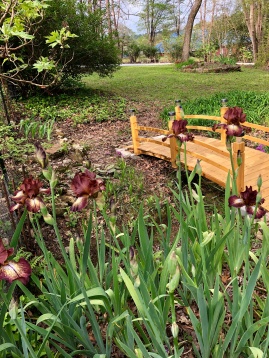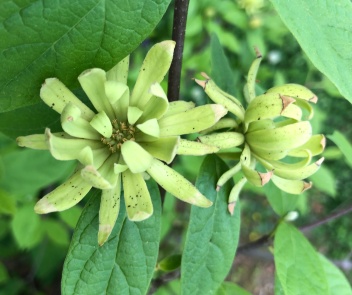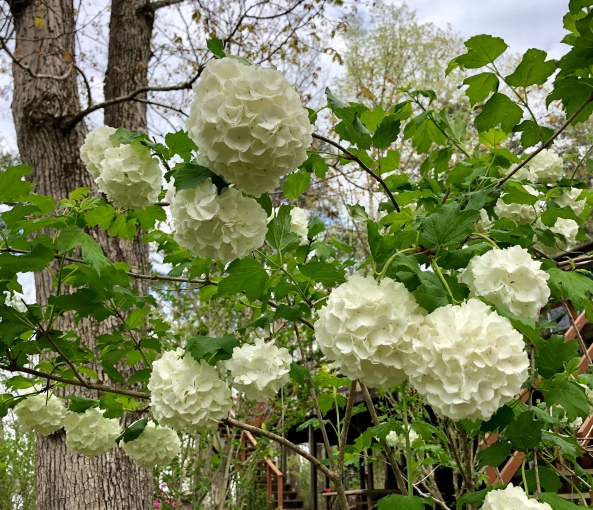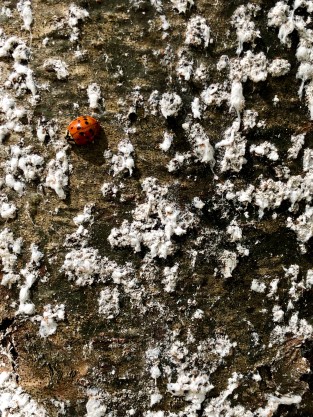My six offerings for this Saturday include five blooming perennials and shrubs and one sad story. I’ll save the unhappy offering for last.
1. Bearded Irises (Iris germanica) just began blooming. There are several varieties about to open but the one in the featured image and below is first every season. These stunning chocolate and maroon blooms are great candidates for cut flowers.


2. Columbine (Aquilegia) is noted for attracting hummingbirds and bees. Unfortunately, I find that in Alabama the blooms disappear long before the hummingbirds appear. The bees, though, are certainly in attendance as can be seen in the second two photos below. These bees, however, are carpenter bees, and they are also drilling their way into the woodwork around the outside of the house.
3. Sweet shrub (Calycanthus floridus) goes by several common names including Carolina allspice, spicebush, and strawberry bush. I find its most charming name the one I first learned, sweet bubby bush–so called reportedly because woman once gathered the sweet smelling blooms and placed them in with their undergarments to give them a pleasant scent. Pictured below is the ‘Athens’ cultivar that has a yellow flower rather than the typical deep maroon bloom, which I find more attractive and aromatic. Some late season frosts unfortunately burned the ends of the petals of early buds this year.


4. Snowball Bush (Viburnum macrocephalum) is a shortened version of the common name for this viburnum, Chinese snowball bush. But to me, the wonderful bush in the corner of my grandmother’s yard was just the snowball bush. A week ago this plant’s blooms were bright lime green. Happily, yesterday they were recognizable “snowballs.” I am pleased that this shrub is finally coming into its own after a decade of growing in not quite enough sun.

5. Azaleas, conversely, have flourished throughout the garden in full sun and partial shade. Alabama natives have bloomed in Birmingham already, but in Blount County a little northeast of Birmingham, they are just budding. The non-natives are full of color, though.

6. And now for the sad story. My Curly-leaf Eastern White Pine was one of my prized trees for 20 or more years, but this post is essentially its obituary. It will be taken down in the next week or so because of an insidious insect, the pine bark adelgid (Pineus strobi). Adelgids are covered with a white wax and suck sap from the tree. Once an infestation has set in, there is apparently nothing much that can be done other than to, as the local horticulture agent advised me, “cut it and burn it” to keep the insect from moving on to some tasty new pine. As seen below, what was a year ago a thick, shapely tree with silvery green twisted pine needles is little more than a skeleton now. The white patches visible on the length of the trunk are evidence of the adelgids. The size, thanks to the appearance of a ladybug when I took this photo, and coverage of the infestation can be seen in the second photo. It is all along the trunk and making its way out to the branches.


I sincerely hope that none of my fellow gardeners elsewhere in the US or in other areas of the world will fall victim to adelgids.
Readers of After Eden can join Six on Saturday posts by following the guide found at “the propagator’s” blog, https://thepropagatorblog.wordpress.com/2017/09/18/six-on-saturday-a-participant-guide/.





Beautiful photos of lovely flowers. So sorry about the huge pine!
LikeLiked by 1 person
Sorry about your pine. When I bought my place, there were two acres planted in white pine. Alas, the pine bark beetle has decimated them, and that corner of the property now looks like pickup sticks. I have two hemlocks, and dread the day when I see the almost inevitable signs of the hemlock woolly adelgid. So far so good, but the Northeast is in trouble. I’m slowly losing ALL my American elms. Hopefully you will be able to replace the pine with something that might be resistant. Thank you for all the lovely pictures. Those iris are stunning!
LikeLike
Oh, I’m sorry about your pine it does look very sick in the photo. On the other hand, the Azalea is very healthy, and an eye-poppingly bright colour. Quite magnificent.
LikeLiked by 1 person
Gorgeous photos. You are way ahead of us in the mid-Atlantic in terms of blooming things.
LikeLiked by 1 person
I’m from Maryland and used to love driving from Alabama to Baltimore County during spring break and watching the stages of spring move in reverse.
LikeLike
Beautiful snowball bush! WE have been nurturing a cutting from a much older plant for well over two decades; it thrives but has yet to bloom. You give us hope! Another lovely Saturday. I trust that your area was marked safe from the storms of last evening.
LikeLiked by 1 person
Yes, we were safe—no damage. But I was watching tornado coverage from 2:30 a.m. until 6 a.m.!
LikeLike
Beautiful plants, Susan. That iris is stunning! A shame about your pine. Our hemlocks have been plagued by wooly adelgids (non-native from Japan), but have responded well to Neem oil treatment during molting stage. (Neem is a natural plant-based pesticide.) But your pine might be too far gone, so sad.
LikeLike
Invasive insects and plants are becoming quite the problem, aren’t they? Thanks for the Neem oil hint. Do you know whether it is effective on pine bark beetles?
LikeLike
I like your snowball bush, not one I’m familar with. Shame about your pine.
LikeLike
I did not know that anyone else wrote obituaries for trees. I have written a few, and will be writing another for a pair of flowering cherries at work. I must cut them down because they are so mutilated by the earlier removal of necrosis.
LikeLike
Your Calycanthus florida looks very much like our Calycanthus occidentalis, except that the flowers of ours is dark brownish burgundy. They smell really weird. I really like them.
LikeLike